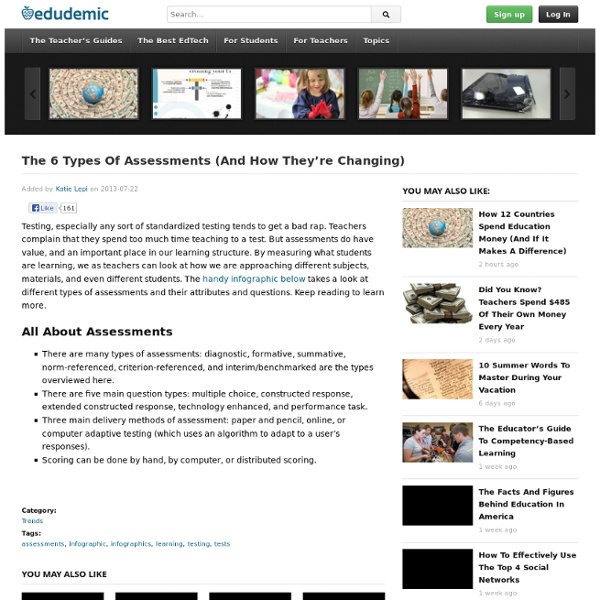The 6 Types Of Assessments (And How They're Changing)
Testing, especially any sort of standardized testing tends to get a bad rap. Teachers complain that they spend too much time teaching to a test. But assessments do have value, and an important place in our learning structure. There are many types of assessments: diagnostic, formative, summative, norm-referenced, criterion-referenced, and interim/benchmarked are the types overviewed here.
fizwiz : #assessment Add you paddle...
10 Assessments You Can Perform In 90 Seconds
Good assessment is frequent assessment. Any assessment is designed to provide a snapshot of student understand—the more snapshots, the more complete the full picture of knowledge. On its best day, an assessment will be 100% effective, telling you exactly what a student understands. This makes a strong argument for frequent assessment, as it can be too easy to over-react and “remediate” students who may be banging against the limits of the assessment’s design rather than their own understanding. It is a huge burden (for both teachers and students) to design, write, complete, grade, and absorb the data into an instructional design sequence on a consistent basis. Simple Assessments The word “simple” here is misleading. Then, due to their brevity, they’re simple to grade–in fact, you can grade them as exit slips–which makes taking the data and informing instruction (the whole point of assessment) a much simpler process as well. 1. 2. 3. 4. 5. 6. 7. 8. 9. Draw what you do understand. 10.
Luis Antonio Tagle, Filipino Cardinal, Stirs Papal Talk With Rapid Rise
IMUS, Philippines -- Asia's most prominent Roman Catholic leader knows how to reach the masses: He sings on stage, preaches on TV, brings churchgoers to laughter and tears with his homilies. And he's on Facebook. But Philippine Cardinal Luis Antonio Tagle's best response against the tide of secularism, clergy sex abuse scandals and rival-faith competition could be his reputation for humility. His compassion for the poor and unassuming ways have impressed followers in his homeland, Asia's largest Catholic nation, and church leaders in the Vatican. Tagle's rising star has opened a previously unimaginable possibility: An Asian pope. The Filipino prelate's chances are considered remote, as many believe that Latin America or Africa – with their faster growing Catholic flocks – would be more logical choices if the papal electors look beyond Europe. "There are people, even Vatican officials here, who have whispered to me, `Tagle, he's the man,'" Thavis told The Associated Press. Also on HuffPost:
How to BYOT for Learning?
I have been out visiting a lot of schools over the past few months learning about culture, demographics, economic status of neighbourhoods, existing and historical use of and interest in technology, and capacity to weave technology into common practice. My District has a fascinating array of schools. I was in a 105 year old secondary school last week in a highly urban area with a rather low socio economic status. The school is quite oddly designed and has an institutional feel and look, but I suppose 100 years ago architects and District officials thought differently about school. is a 21st century design with open aggregation spaces, learning communities for grade pairs with varied sizes of learning studios (aka classrooms). I seem to increasingly find myself entering into bring your own technology (BYOT) conversations during my school visits. For a BYOT approach to be successful we need to ensure we have key technical requirements in place: Contexts and challenges to figure out:
Related:
Related:



